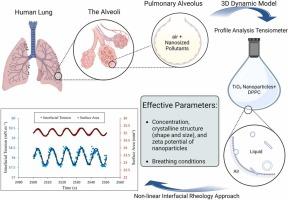Dynamic Interactions of Titanium Dioxide Nano-Pollutants with a Lung Surfactant Model: A Nonlinear Interfacial Rheology Study
IF 12.2
1区 环境科学与生态学
Q1 ENGINEERING, ENVIRONMENTAL
引用次数: 0
Abstract
TiO2 nanoparticles are highly produced nanomaterials from industry and commonly found in the air we breathe, but their interactions with lung surfactants and impairing lung functions have not well understood. In this study, effects of two crystalline structures of TiO2 nanoparticles, i.e., anatase and rutile, with their various sizes, shapes, surface charges and concentrations, interacting with a single-component model of pulmonary surfactant, were studied. Nonlinear interfacial rheology was used to quantitatively distinguish effects of nanoparticles at different stages of breathing cycles. Oscillation studies which simulated the breathing cycles in different human ages showed that both crystalline structures of TiO2 nanoparticles made nanoparticles-dipalmitoyl phosphatidylcholine (DPPC) system more viscous, dissipative and irreversible during the oscillations, thus affecting the normal operation of lung surfactant. At the least concentration of nanoparticles studied, i.e., 0.01 wt %, the anatase ones significantly affected the expansion part of the cycle, whereas the rutile ones affected both expansion and compression phases. Interactions between DPPC and TiO2 nanoparticles under dynamic conditions of breathing cycles were affected by the crystalline structures and concentrations of nanoparticles and breathing conditions, with key factors including physical properties, such as sizes, shapes, and zeta potentials of nanoparticles. These results are crucial for understanding the adverse effects of nanosized pollutants in the lungs and applying drug delivery into lungs.

求助全文
约1分钟内获得全文
求助全文
来源期刊

Journal of Hazardous Materials
工程技术-工程:环境
CiteScore
25.40
自引率
5.90%
发文量
3059
审稿时长
58 days
期刊介绍:
The Journal of Hazardous Materials serves as a global platform for promoting cutting-edge research in the field of Environmental Science and Engineering. Our publication features a wide range of articles, including full-length research papers, review articles, and perspectives, with the aim of enhancing our understanding of the dangers and risks associated with various materials concerning public health and the environment. It is important to note that the term "environmental contaminants" refers specifically to substances that pose hazardous effects through contamination, while excluding those that do not have such impacts on the environment or human health. Moreover, we emphasize the distinction between wastes and hazardous materials in order to provide further clarity on the scope of the journal. We have a keen interest in exploring specific compounds and microbial agents that have adverse effects on the environment.
 求助内容:
求助内容: 应助结果提醒方式:
应助结果提醒方式:


